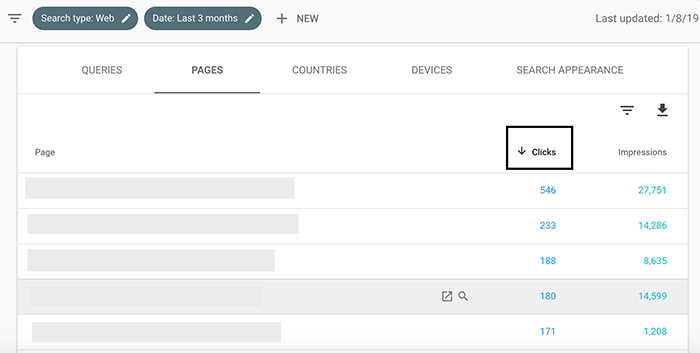Part of the reason we create content is that we want to break through the noise but I often wonder, should I create new content or improve existing content?
Build An Income-Generating Website That Lasts Decades!
Earn online income for a lifetime.
>>Start Now<<
Content is probably the most important aspect of search engine optimization (SEO). It’s the fuel that powers growth for any form of digital marketing. Being able to produce high-quality content on a consistent basis is paramount.
As your site grows, some content will become out of date. You’ll also begin to realize you made a lot of mistakes in the first phase of building out your affiliate website. So as continue to build out a content strategy for your website should you create new content or improve existing content? In this article, I’m going to provide you with the insights and tools necessary to always make the right decision for your blog or website.
New is always appealing but what if I told you that it shouldn’t be your first route?
A study by HubSpot found that companies who published 16+ blog posts per month received more web traffic than the ones that didn’t. So clearly, there are benefits to creating new content. More content simply means more chances to rank. It’s more words on your site. It’s a bigger spider web to catch eyeballs searching the web.
But, placing too much focus on developing new articles can also cause us to miss other important areas of SEO, as well as retain all the benefits of our previous work. Ignoring old content can allow competitors to scoop up the rankings you neglect!
Generally, the more content you have on your site, the greater the cost of keeping them up to date. While this is fine if you have the manpower and resources, it’s not easy for a single-person operation. So where should you spend your resources?
- Answer: Do Both
- How to Decide Whether to Create New Content or Improve Existing Content
- Do you have publications that are not receiving any traffic?
- Do you have content that’s receiving some traffic but you know they can perform better?
- How to Improve Your Content Like a Pro
- 1. Rewrite The Content
- 2. Combine Old Content
- 3. Improve/Optimize The Content
- WARNING: Don’t Get Attached
- When to Create New Content? Always!
- Video: Write Better Content, Faster, On A Regular Basis
Answer: Do Both
Really, you should be doing both. You should be creating new content consistently, and you should be improving old content. The best way to divide your labor (time/money) is to only focus on old content which is already performing well, and optimize for more conversions.
It’s easier to improve something that’s working already than it is to “fix” something which doesn’t work.
How often you create new content will depend on your schedule, the depth of your content, and your ability to outsource. With a budget, you can outsource a lot of the work!
How to Decide Whether to Create New Content or Improve Existing Content
As previously noted, it’s easy to become overly focused on relentlessly pumping out new content. Naturally, we want to stay ahead of our competitors on the SERPs (search engine results pages). Newbies, especially, often think they can win by publishing massive amounts of content alone after reading that HubSpot study (often times, that is the case, but if your competitors have a team of writers, you won’t be able to keep up!)
Think about the following questions. (PS, if you don’t know how to look at your traffic stats, set up Google Analytics and Search Console)
Do you have publications that are not receiving any traffic?
Any content that receives little or no clicks from the SERPs should be either cut loose, or focused on. Make a decision! Content is only valuable if people pay attention to it. Large resources, or super helpful pages can have traffic funneled to them through internal links. You can also improve the rank of pages like this by editing to properly optimize for keywords. You can also make concerted backlink efforts for these pages.
Don’t save every page though. Some are just better ignored. You can redirect to a more relevant page, or update the content briefly to send people to your more current work.
You can use Google Search Console (GSC) to find the culprits.
Once you’ve logged into GSC, select your website from the dropdown list located on the top left corner. Then click on ‘Performance’, which can be found on the left navigation bar. Make sure you’ve got the date range set to ‘Last 3 Months’.
Select the ‘Pages’ tab. To sort the list in descending order, simply click on the column’s name, ‘Clicks’. GSC will now order rows by displaying the pages that receive the most traffic first.
It’s ok to focus on new content creation if all your content is receiving web traffic.
Scroll down a bit further to locate all the pages on your site that aren’t getting any traffic from Google.
Do you have content that’s receiving some traffic but you know they can perform better?
These are publications that receive incoming traffic but too few to matter. Sometimes we may create new content that does really well in the beginning, however, falls flat after a few months. There are many possible reasons why this happens.
Things to look for include search volume of the topic, average position, CTR, SERP features, how much space paid ads occupy etc. Note that GSC does not provide keyword search volumes. So you’ll need a third party tool like Keywords Everywhere for that.
Install their Chrome or Firefox extension and you’ll be able to instantly see the search volume of any keyword you type into Google. Here’s a quick example.
GSC becomes much more powerful the moment you install Keywords Everywhere because it perfectly compliments it.
Tools like this can showcase what your content is doing versus what it should be doing. Are you ranking on page 1, spot #6 and seeing zero traffic for an in-demand keyword? This is a great opportunity to improve the rank of this page. You’re already doing something right. Time to improve upon it!
How to Improve Your Content Like a Pro
If you have a lot of dead-end content that isn’t receiving traffic or perhaps, they could perform better, then updating is the recommended option in both cases.
Try to think about it in this way. Since you’re either getting nothing or barely anything, it wouldn’t matter if you made changes to these kinds of articles. Especially, when your search competitors are kicking your butt. As I mentioned before, garbage content can be left alone. I have lots of old articles like that. As the bare minimum, I add some internal links, and leave it alone. Better content, even if it’s garnering little traffic, may be worth more of an effort.
Whatever you decide, here are a few things you can do to improve existing content on your website.
1. Rewrite The Content
A complete rewrite could be in order. If you are really attached to the idea of keeping all the pages on your website 100% quality, and this article is not ranking, you can at the very least make the quality better. In this rewriting process, you can optimize for a different (similar) keyword, or keep the same keyword and use your recent experiences/knowledge to simply make a better page.
You’ll want to keep the web page URL the same so that you can leverage any link equity that you’ve already gained. What have you got to lose?
2. Combine Old Content
You may have a bunch of content that isn’t worth updating and if so, they can be perfect candidates for a combination. These articles can be combined into a one-piece publication if their topics are relatively similar.
Just make sure that you choose the URL with the most authority as your base for the combined article. And of course, 301 redirect all the other web addresses to the new page.
3. Improve/Optimize The Content
Update your content if it’s out of date or missing the latest information on its topic. For instance, a blog post about machine learning that was written five years ago could be due for an update. It’s always a good idea to go over your content regularly.
But aside from the written text itself, you can also do things like add images, videos or a call-to-action (CTA) that can help you convert more readers on that page. Maybe your goal is to increase social shares, sales or acquire more subscribers. Changing old content to be more in line with your current business path can give you more leads, more sales, and get you closer to your goals.
WARNING: Don’t Get Attached
We’re all human. Sometimes, we spend a lot of time creating content that just doesn’t rank or perform. It sucks. Don’t get attached to the content though. Spending hours and hours trying to get something to rank can be a huge waste of time, when you could be creating new stuff, targeting new keywords, and reaching new audiences.
You can always funnel traffic to your precious pages that don’t rank. I have no doubt in my mind that my SEO checklist will not rank. Page 1 is filled with authoritative sites, and it’s a high competition phrase. I’m not concerned about it though! I can internally link within my own content and send relevant traffic to the page.
I can write content about relevant low competition phrases, then funnel that traffic to my high-competition pages.
For example, you’re reading this page improving old content and writing new content. Now you can read my SEO recommendations to help you create said content!
When to Create New Content? Always!
Throughout this article, I’ve focused a lot on improving old content. I just wanted to get that out of the way. However, I actually think creating new content is always going to be your most powerful tool for ranking. Consistently producing fresh, quality content is a surefire way to rank in Google. Not only do you get more chances to rank with more words on the page, but you also signal to Google that you know a lot about what you’re writing about (or at least that you have a lot to say).
The #1 thing that stops newbies from ever seeing success is not writing enough volume of content, whether that be on a single publication, or across many articles on an entire website.
To get started writing awesome content that ranks, here are the resources I recommend:
- Write A Basic 1,000 Word Article
- What To Write About
- Design A Beautiful Blog Post
- Rank with SEO
What’s up ladies and dudes! Great to finally meet you, and I hope you enjoyed this post. Sign up for my #1 recommended training course and learn how to start your business for FREE!



